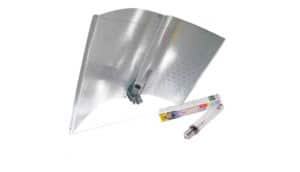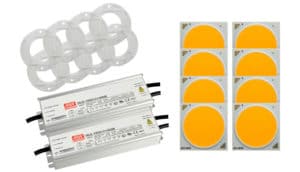Inhaltsübersicht
In this section we will show you the differences between a High Pressure Sodium light and COB-LEDs and highlight why the LED system represents a big step forward in the field of plant lights. We will begin with a look at the basic equipment. Since we want to compare the efficiency of both systems, we’ll put together two 400 watt setups.
Die 400w High Pressure Sodium | 8x Cree LEDs each 50w |
| Components - 400w HPS bulb (i.e. Sunmaster) - 400w light ballast (EVG) - reflector(Adjust-A-Wing) - socket cable | Components - 8x Cree LEDs (CXB 3590) each 50w - drivers - cooling element - cables, angle brackets, mounts |
| HPS data - lumen: ca 55.000lm - luminance efficacy: up to 130lm/w - thermal loss: at least 60% - efficiency: 25%-40% | 8x LED chips data - Lumen: ca 72.000lm (at 8x50w) - luminance efficacy: up to 182lm/w - thermal loss: at least 35% - efficiency: 45%-65% |
Gas-discharge lamps like high pressure sodium lights spread their light in all directions. As a result 50% of the light needs to be reflected which in turn leads to a considerable loss of light. Our LED plant lights equipped with Cree LED-chips have a dispersion angle of 115°. Combined with the right set of reflector and holder nearly all of the light can be directed at the plants at a dispersion angle of 90°.
After comparing set ups and technical performance values of high pressure sodium lights and Cree LEDs we will now cover some essentials and then show the results of our comprehensive tests in our second part of our comparison